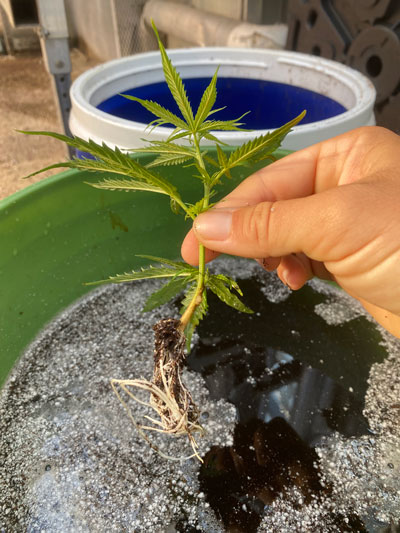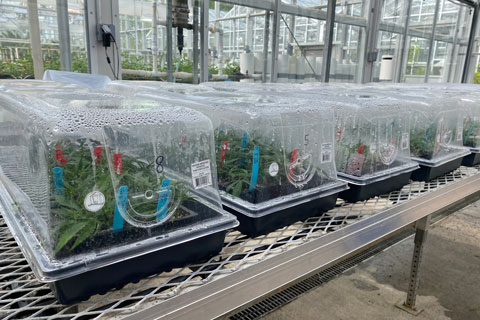5/1/2024
Successful Cannabis Propagation
Alexandra Carver and Jim Faust
Cannabis propagation can be a challenge. Growers often report just 65% to 75% of their cuttings are ready for transplant in three weeks. These relatively low propagation success rates create significant economic challenges due to the waste of labor, materials and space. So we performed a series of experiments with the goal of reliably achieving >95% success rates.
The objective of our research at Clemson University was to investigate multiple factors affecting adventitious root formation in hemp cuttings so that best management practices could be developed to allow for consistent propagation success. Specifically, experiments were conducted to examine the effects of rooting hormone, substrate moisture content and the nutrition program delivered to the stock plants and the cuttings.
Rooting hormone
Auxins are a group of plant hormones that are commonly applied to cuttings to promote adventitious root formation. The two most common auxins are indole-3-butyric acid (IBA) and 1-naphthalene acetic acid (NAA). These compounds are available in several forms (liquids, powders, gels), require different solvents (alcohol or water) and are applied by several different methods (basal stem dip, foliar spray, whole cutting dip). For our experimentation, we used the water-soluble forms (potassium-salt forms of IBA and NAA known as K-IBA and N-NAA) applied as a basal stem dip (2 cm deep) for five seconds. Other approaches are equally valid and the best choice will vary among growers, however, these choices may affect the rooting hormone concentrations applied.
 Figure 1. On Day 14 after sticking, cuttings were removed from propagation and the substrate was rinsed from the roots. Roots were cut off and weighed.
Figure 1. On Day 14 after sticking, cuttings were removed from propagation and the substrate was rinsed from the roots. Roots were cut off and weighed.
We applied 16 combinations of IBA (0 to 6,000 ppm) and NAA (0 to 6,000 ppm), propagated the cuttings under mist and recorded root mass after 14 days (Figure 1). Seven industrial hemp cultivars (strains) were used. In all cases, any combination of IBA and NAA provided better rooting than the control group that received no rooting hormone. Optimal concentrations of rooting hormone were specific to each variety, but were generally in the range of 2,000 to 4,000 ppm, while the most difficult to propagate cultivars benefited from hormone concentrations up to 6,000 ppm.
Some cultivars responded more strongly to IBA, while others rooted better with NAA. This may cause complications for growers who propagate many cultivars, so trials are necessary to identify optimal rooting hormone concentrations for your specific cultivars. As a starting point, the treatment combination of 4,000 ppm IBA and 4,000 ppm NAA resulted in the best rooting across all of the cultivars tested in our study, e.g., 94% of cuttings showed root initiation by day 14.
Substrate water and air
Propagation substrates can be described by their physical components and pore space (porosity). Container capacity refers to the amount of water held by a substrate after it’s been irrigated to saturation and then the excess water is allowed to drip out of the bottom of the container. Container capacity is dependent on the container height, as well as the substrate used.
In our experiment, the substrate (loose-fill peat) was maintained at a constant container capacity of 70%, 80%, 90% or 100%. The cuttings were propagated in 72-cell trays covered with domes (Figure 2) to prevent the mist from affecting the substrate moisture content.
The results showed a linear increase in root mass as container capacity increased. Surprisingly, the best rooting occurred at the wettest treatment, but these results must be interpreted carefully. The 100% container capacity treatment had 28% air space (porosity). This was possible because the propagation container height was 5.4 cm (~2 in.), which is a relatively tall propagation container and taller containers have greater porosity than shorter containers.
Note that compaction and substrate particle size also contribute to a substrate’s air porosity. These results may explain why cannabis seems to root better in rockwool and phenolic foam, which both have high porosity. In other words, if the substrate is sufficiently aerated at 100% container capacity, then it becomes difficult to overwater since excess water applied simply leaches from the substrate, leaving adequate air porosity at all times.
Fertilizer strategy
The fertilizer strategy starts with the stock (mother) plants and continues through the propagation cycle. Stock plants need to be provided with adequate fertilizer to produce cuttings with enough nutrients in the leaf tissue to supply the cutting through the initial days in propagation. Once in the propagation environment, fertilizer can be applied to the cuttings through the mist as a foliar feed or added to the substrate as a drench.
It’s well-documented that the nutrient content of cuttings decreases rapidly during the first week in propagation under mist systems that supply only water. For example, a cutting may initially have 5% nitrogen (dry mass basis), but after one week in propagation that may drop to 3%. Thus, a well-fertilized stock plant provides higher initial tissue nutrient concentrations that sustain the cutting during the early stages of propagation. Nonetheless, it’s important to start supplying nutrients at the start of propagation in order to minimize this drop in nutrient concentration. It tends to be easier to apply nutrients in the mist, but irrigating the substrate also works.
 Figure 2. Cuttings maintained under 7.5-in. humidity domes during fertilizer experiment.
Figure 2. Cuttings maintained under 7.5-in. humidity domes during fertilizer experiment.
For this experiment, we applied a complete fertilizer to stock plants through irrigation (fertigation) at concentrations of 100, 200 or 300 ppm N. Cuttings from each stock plant treatment were harvested and propagated in a peat-based substrate that was then fertigated to 100% container capacity with 0, 100 or 200 ppm N. Cuttings were maintained under humidity domes to prevent additional water from entering the substrate and potentially leach nutrients from the substrate. On Day 7, the substrate was irrigated again with the respective fertilizer treatments. Root mass was measured on Day 14.
Two floral hemp cultivars were used in this study. Peach Haze, a hard-to-root cultivar, responded positively to the stock plants being fertigated with 300 ppm N. The easier-to-root THM Jack responded well to moderate fertilizer concentrations (200 ppm N). Stock plants fertilized with just 100 ppm N were a lighter green color and visually smaller by the final weeks of the experiment. Once in propagation, Peach Haze produced the most roots when receiving 200 ppm N, while THM Jack preferred 100 ppm N. Thus, 200 to 300 ppm is suggested for the stock plants, while irrigation applications of 100 to 200 ppm N are suggested for Day 1 and 7 in propagation. Excess mist must be avoided to minimize nutrient leaching in propagation.
Best management practices
Many cannabis propagators utilize domes placed atop individual trays rather than using mist propagation systems. Growers consistently report greater success while propagating under domes. However, domes are inefficient to use and often limit one’s ability to propagate large numbers of cuttings simultaneously due to the extra labor and expenses associated with adding, removing and disinfecting the domes. Nonetheless, the success observed propagating with domes does provide a clue towards creating the proper water and nutrient delivery for propagation success.
As a result of our experimentation, we hypothesize that propagation of cannabis with rockwool or phenolic foam substrates under domes works well because these substrates are difficult to overwater and easier to maintain optimal substrate moisture content, and the domes prevent leaching of nutrients from cuttings due to excessive mist application. We find that mist is often over-applied because cannabis leaves are relatively quick to wilt, especially when propagating large cuttings with large leaves. This is another reason that we prefer small, 2-in. cuttings when propagating cannabis.
Take-home message
The keys to cannabis propagation are:
■ The ideal rates of IBA and NAA will vary, but the combination of 4,000 ppm IBA and 4,000 ppm NAA, using the water-soluble, potassium-salt forms is our preference.
■ A high air porosity substrate. Rockwool and phenolic foams work well. Peat will also work well, but cannot be overly compacted, and propagation trays should be ~2-in. tall.
■ 200 to 300 ppm N applied to the stock plants.
■ 100 to 200 ppm N applied to the cuttings in propagation on Day 1 and 7 as a drench. Alternatively, 50 to 75 ppm N can be applied constantly through the mist system.
■ Avoid leaching nutrients from the substrate either with domes or a well-managed mist system.
■ Following this prescription, we expect to consistently achieve >95% rooting across a wide range of cultivars.
Alexandra Carver is a graduate student and Jim Faust is a professor at Clemson University.